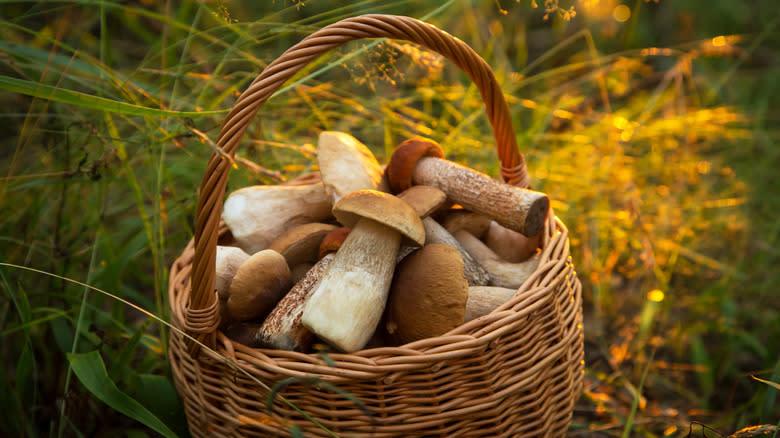Why You Should Let Mushrooms Sit In The Sun Before Cooking Them

Did you know you can get your daily dose of vitamin D from mushrooms? According to the U.S. Department of Health & Human Services, the recommended amount of daily vitamin D for adults between 19 and 70 years old is 600 IU (International Units), which you can get from spending time in the sun. But for those wanting to limit their UV exposure, just up your daily mushroom intake to fill your vitamin D quota.
On their own, 100 grams of white raw mushrooms only contain about 7 IU of vitamin D, so you'd have to really love these veggies to get the amount of the nutrient you need. But you can multiply that amount by letting your mushrooms spend a little time sunbathing outdoors. According to a study published in Nutrients, "When commonly consumed mushroom species are exposed to a source of ultraviolet radiation, such as sunlight or a UV lamp, they can generate nutritionally relevant amounts of vitamin D." The study found that after just 15 minutes in the midday, mid-summer sun, the vitamin D content in sliced mushrooms jumped up to 700 IU or 17.5 mcg per 100 grams, which is more than the daily recommended amount for most adults. And after one hour, the fungi contained a whopping 1,300 IU of the nutrient.
Read more: What Happens If You Accidentally Eat Mold?
How To Supercharge Your Mushrooms With Vitamin D

If you want to reap the benefits of vitamin D-packed mushrooms, here's what to do. First, you'll want to clean them since the sunlight will help them dry more quickly than they would inside. Then, per the Nutrients study, slice them to increase the surface area that can absorb the essential vitamin. Spread your slices out in a single layer on a baking sheet or any kind of flat tray and place them outside in the sun between 10 a.m. and 4 p.m., when the sun's rays are the strongest. During this time, a chemical in your 'shrooms called ergosterol will react with UV rays to generate and soak in even more vitamin D.
Try to leave your fungi out in the sun for an hour to maximize nutritional value, but as the study demonstrated, even a quarter hour of exposure can make a huge difference. Keep in mind that the amount of UV rays your mushrooms absorb can vary depending on the season, weather, and time of day -- although, as a study published in the Journal of Nutrition & Food Sciences noted, the sun-soaking fungi can still produce more vitamin D on cloudy days. As long as they have a little time out in nature, they'll help you stay out of the sun and meet your nutritional needs.
Read the original article on Tasting Table.


